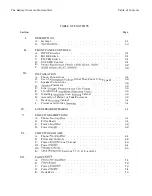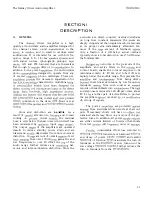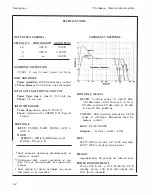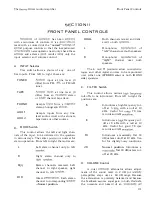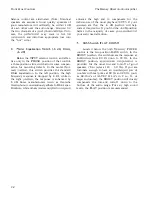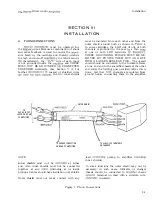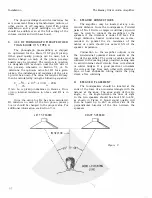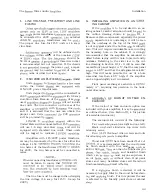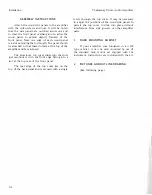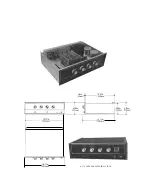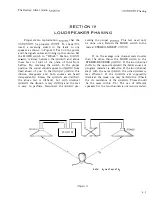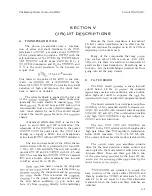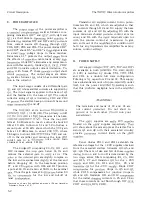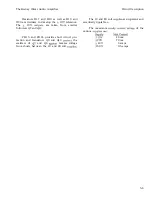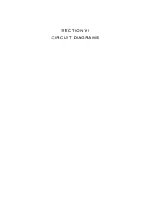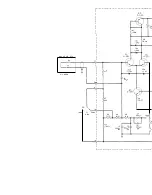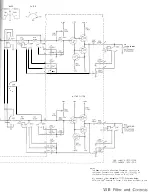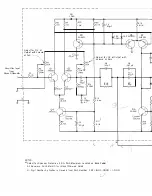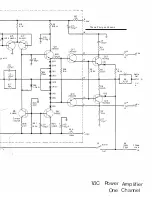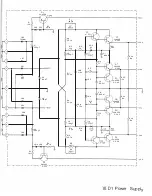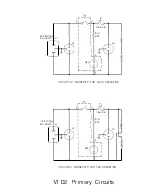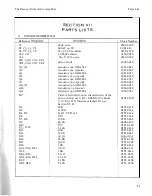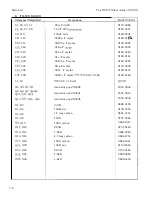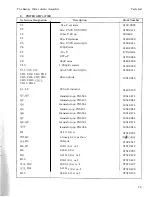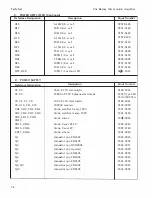
Circuit Description
C.
POWER AMPLIFIER
The
the power amplifier is
emitter follower com-
prising transistors Q12* and
*, with QlO and
as their drivers.
point
is
provided
resistors R5* and R6* and by currents
from current source Q8
through
CR9, R22, CR8 and CR6. The power diodes CRI *
and CR2* shunt R5* and R6* at
signal levels
to avoid
voltage drops in these resistors.
Inductance L1 * protects the output
from
the effects of
cable loads at very
while R8* eliminates any series reson
ance with this capacity. Diodes
CR12
and CR13 provide output current limitation. To-
with fuses F* these
output short
circuit
The output stages are driven
emitter follower
which has current limita-
tion in the collector.
The input
consists of a differential pair,
and Q2, whose emitter currents are supplied by
The input signal is applied to the base of Ql
and the feedback to the base of Q2. The output
collector swing of Ql is limited
CR2 and CR3
to
the emitter-base junctions of the second
and Q7.
The
at d-c and low
is
( >
100 dB). The primary cutoff
at
frequencies is the base-
Thus the loop
falls at 6 dB/octave to reach a value of about 60
dB at 10 kHz. Inductors Ll and L2 introduce a
second pole at 16 kHz above which the
gain
falls at 12 dB/octave to about 200
where
C6 begins to shunt Rl6
a
end cut-
off in the amplifier and reducing the loop
cutoff rate to 6
once more. Gain
crossover is at about 1 MHz.
The bridged-T comprising C3,
Rll, and
R12 increases the
below 16 Hz and
reduces the external
at d-c. The
are
complex so
the low end response rises
at the low end
before dropping off. In the bass-boost position
C7 and C8
with Rl6 and R17 produce
a pole at 16 Hz and a zero at 80 Hz in the external
most
Thus the gain rises at 6
below 80
for the low end roll-off of
'Located on chassis. See righthand portion of Power Amplifier
Schematic, Section VI,
C.
5-2
The
Oliver Audio Amplifier
Transistor Q3
current to two poten-
tiometers R4 and
which are
so that
the currents through R2 and R3 supply the base
currents of Ql and Q2.
R5 with the
input terminals shorted
control at mini-
and R4 with the
terminals open (or
with the volume control at maximum) to give
zero volts out of the
this condition will
hold for any
faces (any
volume control
D.
POWER SUPPLY
All supply
are available in both
(±
40V) is rectified by diodes
and CR4 in a double full wave configuration.
Filtering is
capacitors C3 and C4. This supply
has a substantial amount of ripple,
under
but the power
is such
that this
negligible hum in the
-WARNING-
The terminals and leads of C3 and C4 are
not current
Do not short to
or to each other. (You'll ruin your
The
supplies are
10V
floated on the
supplies respectively.
will show about the same ripple as the latter. Tran
sistors Ql and Q2 with their associated circuitry
provide
current limits on the
Zener diodes CR13 and CR14 establish the
reference voltages for the
±
20V supplies obtained
from the cascaded emitter followers Q3-Q5, and
Q4-Q6. The rate of rise and fall of these
tum on and tum off is determined by the
active filters comprising
Rl3
R15, C7 and transistor
for the
+
20V
and RIO, C6, Rl4 and
C8, and
for the -20 V
Diode CR17
for
drops in Q5 and
while CR18 compensates for junction drops in
Q6 and Q8. Resistors Rll and Rl2
for the initial
currents in C5 and C6 so
that these currents do not flow through R17,
CR17 and
R20, CRIS.
Summary of Contents for Barney Oliver
Page 1: ... 3 AMPLIfIER ...
Page 11: ... ____ 10 93in 278 NOTE CASE IS AN EXTRA PRICE OPTION ...
Page 16: ...eTION V I IR UIT DIAGRAMS ...


